Sometimes the combination of our expectation for rain mixed with the anxiety of it not arriving leaves us once again with a make-believe winter. Nothing has helped to date, so……the time has come to turn to witchcraft!
What we need is a book of incantations, brewing up a concoction of some thirsty clods of earth, dried up-snails, a few strands of tresses turned white from worry, summer vegetables (who just want to return their gear to the quartermaster and head off into the sunset), mix them all together, mumble some mumbo jumbo, and abracadabra – the heavens open up and shower us with a luscious, rainy, cold and satiating winter. True winter.
But in the meantime, we appreciate every droplet of rain in our field, cheering on the drop in temperature, hoping and praying and wishing for a blessed rainy winter. Joining in our hope and anticipation are the winter vegetables, including the very prominent Brassicaceae family. One branch in its family tree is the lovely mustard family and its members, the broccoli, kohlrabi and cabbage who have already visited your boxes. The cauliflower is on her way soon, along with their close cousins the very strong roots growing underground. If any vegetables can make magic happen, it is them! So in honor of the return of the Brassicaceae roots, I am re-posting a bewitched Newsletter. Cackle, cackle…
Radish, Turnip, Eye of Newt……………..
In a popular Hebrew book that my daughters love about five witches (by Ronit Chacham), radishes and turnips are major ingredients in the brew concocted for a spell cooked up by five very amusing witches. As it turns out, not only witches crave these vegetables. Among us mortals and muggles, the turnip and radish (along with baby radishes and daikon) can be just as vital in a potion to ease the common cold, cough, mucous buildup, hoarseness, infections and other winter ills. Winter is the season in which the members of the Brassicaceae family (formerly the Cruciferae) thrive. They are cousins, not siblings, since the radishes belong to the Raphanus genus and the turnips to the Brassica genus, but today we will sandwich them all together (or stir them in the same cauldron) and discuss their common characteristics.
So we already know that they all belong to the Brassicaceae family, along with such members as broccoli, cauliflower, cabbage and kohlrabi, mustard greens, tatsoi and others. Its former name was the Cruciferae, after the shape of its four-petal flowers, which resembles a crucifix. Here are some examples:
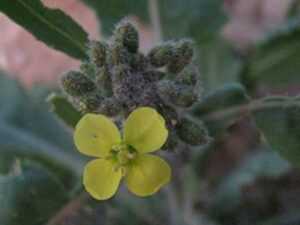
Wild Mustard

Erucaria
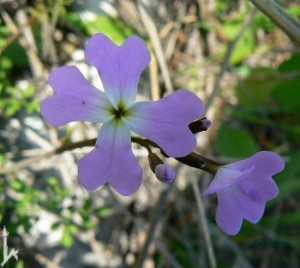
Maltese Cross Ricotia

Wild Radish
The Brassicaceaes are a venerable winter family, and we eat various parts of their plants: sometimes the flower buds (broccoli, cauliflower), sometimes the stem (the thick part, as in kohlrabi) or the leaves (mustard, cabbage, tatsoi, arugula and others) and also the roots, to whom this newsletter is dedicated today: the radish, baby radish, daikon and turnip.
Truth be told, this is a populist division. The good parts of the turnip, daikon and radish are not only found underground – a number of parts of these vegetables can be eaten. For instance, turnip greens are very tasty, and some turnip varieties are grown specifically for their leaves, not roots. Leaves of the large radish are bitter and coarse, but the greens of baby radishes have an esteemed place in the culinary arts. The French add baby radish leaves to potato soup and to add a hint of pungency to salads made of steamed spinach.
Other varieties of radishes and turnips were developed in order to make oil from their seeds. These oils were used in the past, and Maimonides mentions them in discussing oils permitted for Sabbath candle lighting (see Mishnah Torah, Shabbat, Chapter 5, halakha 11).
Radishes and turnips love the cool winter climate, which slows down their breathing and expands the quantity of carbohydrates, a process which improves flavor. Unstable conditions will produce woody roots and a sharp flavor, and they will turn bitter in warm or dry weather. This is why in Israel they are winter symbols – the plants develop thickened roots and fancy leaf inflorescence on their crowns.
And now, some words on each of these vegetables:
The turnip is an ancient domesticated crop that was possibly grown in gardens of old in China, Greece, Rome, Egypt and also here. In kitchens throughout, it was a basic, common vegetable. Assaf the Physician (Assaf Harofe Ben Brakhiyahu who lived in 6th century Tiberias) praised the leaves and seeds of the turnip: “The leaves will be useful for all mental distresses and for malaria, while its seeds will be useful in treatment of pain and all sorts of ailments that lead to death.” However, even the juice produced from the root itself is known in folk medicine as beneficial in treating coughs, hoarseness, mucous buildup, and dryness of the nose and mouth. In natural medicine, turnip juice is used to treat malaise as well as kidney stones. In order to produce juice, one must press the root. Half a kilo of roots make one glass of juice. Half a kilo of squeezed leaves will make half a glass of juice.
At Chubeza, over the past few years we have been growing the familiar type of turnip, with a purplish stain on top, in addition to a special type – a white, round and very sweet turnip. Even confirmed turnip haters have got to try this one out!
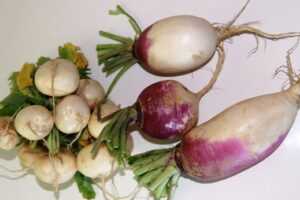
The radish, too, is ancient and prevalent like the turnip. It is considered to be an appetite stimulant and to assist digestion. Take advantage of its refreshing flavor by serving a fresh radish salad between meal courses to cleanse your palates and prepare for the upcoming flavor. The radish’s medicinal virtues are similar to those of its cousin the turnip, beneficial in treating both respiratory and kidney ailments. In addition, turnips are friendly to pregnant women, known to intensify fetal movement (and not as fattening as chocolate) as well as decreasing gas. Soak swollen feet in a radish bath and feel the relief!
There are many varieties of radishes, differing in size, shape, color, and degree of pungency. At Chubeza, we grow radishes and daikons – the long, white Japanese radish. Take a look at several radish beauties:
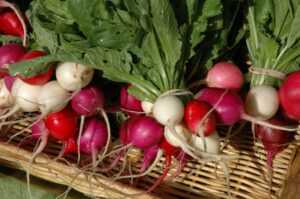
small colorful radishes

Black radish

Daikon radish
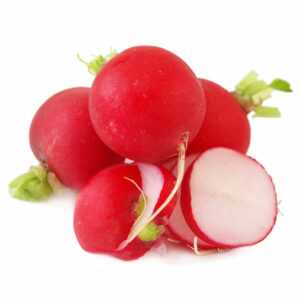
Red radish
Instructions for Storing:
- Radishes and turnips are roots, i.e., their function is to absorb food and water from the earth in order to supply them to the plant as needed. When picked, we disconnect the plant from its current supply, and the roots hurry to transform the material they accumulated to the plant’s leaves in order for them to continue to grow. The root itself will eventually become depleted. Therefore, when you receive a radish, turnip, or daikon (and the same goes for beets and carrots) with leaves attached, you must snip the leaves in order to preserve the root’s contents, to keep it fresh and firm for as long as possible.
- It’s best to store root vegetables in a closed container to isolate them from the processes in the fridge and the materials secreted from other vegetables and food.

Radishes and turnips are great served fresh in a salad or sandwich, but don’t forget to use them in cooking as well. Yes, they can be baked and stir-fried, and they will warm your hearts by adding some coolness to this year’s sultry November.
Impatiently awaiting the rain, which may hopefully arrive at the end of this week. Keep your fingers crossed, like this Daikon fella from our field…
Alon, Bat Ami, Dror, Yochai and the Chubeza team
WHAT’S IN THIS WEEK’S BOXES?
This season is abounding with fresh, delicious greens. This week, we’re sending you a special winter gift of an additional green vegetable. Enjoy!
Monday: Eggplant/potatoes, green & red bell peppers, lettuce, radishes/daikon/baby radishes, cucumbers, tomatoes, carrots, broccoli/cabbage, spinach/totsoi, coriander/dill/parsley, Swiss chard/ kale. Special gift: arugula
Large box, in addition: Turnips/beets, Jerusalem artichokes/Thai yard-long beans, celery.
FRUIT BOXES: Apples, bananas, avocadoes, oranges, clementinas.
Wednesday: Sweet potatoes/potatoes, green & red bell peppers, lettuce/mizuna, radishes/daikon/baby radishes, cucumbers, tomatoes, carrots, broccoli, spinach/totsoi, coriander/dill/arugula, Swiss chard/kale.
Large box, in addition: Turnips/beets/cabbage, Jerusalem artichokes/Thai yard-long beans, celery.
FRUIT BOXES: Apples, bananas, avocadoes, oranges, clementinas.
